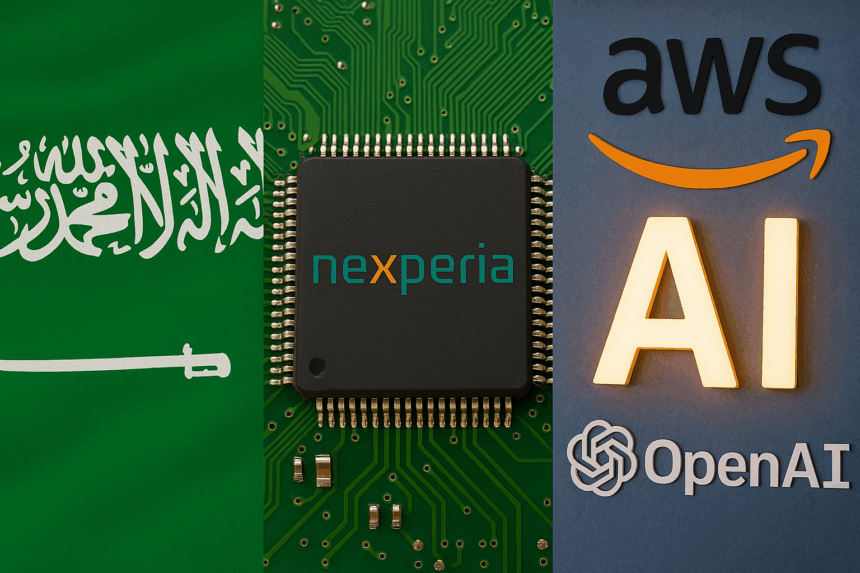The AI Power Struggle — Energy, Chips, and Cloud Deals Enter Another Phase
From Saudi Arabia’s Humain to Nexperia’s chip standoff and OpenAI’s megadeal with Amazon Web Services, the AI race writes another high-stakes chapter. Nations and corporations now treat computing power like oil — scarce, valuable, and intensely strategic.
Each player in the AI arms race is betting billions. Saudi Arabia seeks dominance in energy-driven AI infrastructure. Europe fights for chip sovereignty. And the U.S. doubles down on AI compute alliances between AWS and OpenAI, establishing where and how intelligence itself runs.
What’s Happening & Why This Matters
Saudi Arabia’s Humain: From Oil to Algorithms

Saudi Arabia’s Crown Prince Mohammed bin Salman continues his Vision 2030 campaign to shift the nation’s wealth from fossil fuels to digital frontiers. His newest creation, Humain, embodies that ambition. It is a $1 trillion sovereign-backed AI venture promising to make Saudi Arabia the third-largest AI market on Earth, behind the U.S. and China.
Led by Tareq Amin, Humain plans to build up to six gigawatts of data centre capacity by 2034. It already partners with Nvidia, AMD, AWS, Qualcomm, and Cisco. The firm also announced a $3 billion partnership with Blackstone to construct data centres across the Kingdom.
Amin’s pitch focuses on speed and efficiency. “Look at this country’s energy grid,” he told CNN. “We don’t need to build substations or power lines. That saves 18 months.”

Humain recently launched Humain One, an AI-powered operating system that replaces icons with conversation. Inside the company, AI now handles HR, finance, and legal workflows — leaving a single human on payroll in each department.
This pivot arrives at a critical moment. With oil prices fluctuating and mega-projects like Neom facing delays, AI now anchors Saudi Arabia’s plan for a diversified economy. Yet the Kingdom faces competition from the UAE’s G42, which just secured a $500 billion U.S.-backed “Stargate UAE” data centre project. This is alongside OpenAI, Oracle, and Nvidia.
Nexperia and the Chip Chessboard
Meanwhile, in Europe, Nexperia — a Dutch chipmaker owned by China’s Wingtech Technology — halted semiconductor shipments to Chinese manufacturers. This is under mounting regulatory pressure. The move reveals deep fractures in global chip trade, threatening automotive production and industrial supply chains.

Nexperia cited “geopolitical instability and export compliance reviews” as reasons for the pause. Industry experts read it differently — as Europe’s attempt to assert technological sovereignty amid U.S.-China chip tensions.
With automakers like Volkswagen, BMW, and Volvo relying on Nexperia parts, the disruption exposes how deeply the global industry depends on cross-border silicon.
Analyst Carsten Linz at the European Institute for Innovation noted, “Semiconductors are the new oil — and Europe just realised how much of it flows through political pipelines.”
AWS and OpenAI: Cloud Titans Join Forces
Across the Atlantic, OpenAI and Amazon Web Services (AWS) just inked a seven-year, $38 billion agreement to fuel ChatGPT, Sora, and OpenAI’s upcoming model generations.

The deal grants OpenAI access to hundreds of thousands of Nvidia GPUs, including GB200 and GB300 accelerators, via AWS’s purpose-built clusters. It’s OpenAI’s first major infrastructure deal since restructuring its relationship with Microsoft. This signals strategic planning toward independence.
Sam Altman said in a statement, “Scaling frontier AI requires massive, reliable compute. Our partnership with AWS strengthens the global ecosystem powering this next era.”
AWS intends to deploy the infrastructure by 2026, with room for expansion. Amazon’s stock jumped to an all-time high on the news. Meanwhile, Microsoft’s shares dipped briefly. This is a sign that Wall Street recognises the competitive weight of the new alliance.
OpenAI’s appetite for compute is staggering. Altman’s team plans to invest $1.4 trillion in AI infrastructure to create 30 gigawatts of computing capacity — enough to power 25 million American homes.
TF Summary: What’s Next
The future of AI now depends on three key forces: energy, chips, and computing power. Saudi Arabia bets on energy-driven scale. Europe protects its chip autonomy. And the U.S. consolidates AI infrastructure through corporate coalitions.
MY FORECAST: Expect hyper-AI nationalism — nations linking data, chips, and cloud sovereignty to national power. While Saudi Arabia and the UAE fight for Middle East AI dominance, and the U.S. firms entrench in supercloud deals, the next flashpoint isn’t code — it’s control.
— Text-to-Speech (TTS) provided by gspeech


